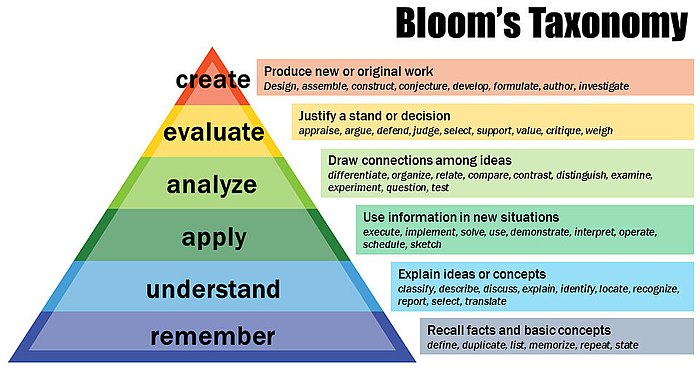As teachers, you probably know about the Bloom’s Taxonomy, a very important theory in teaching and learning. Figure 3 below reminds you of the six levels of the Taxonomy. If you want to learn more about the Theory you can find more information at the following link: (/https://media.citt.ufl.edu/resources/blooms/index.html)
This theory is useful in designing teaching and learning that covers different levels of cognitive domains. In fact, it speaks to the knowledge and skills that one needs to cope with the challenges of work and life in general. For example, we do not need people who can only remember, or can only describe or explain. We need people who can do all these things and also analyse, evaluate and create. We need to cover these various cognitive skills when we design teaching and learning as much as we need to do so when we design assessment.

To ensure that you cover all the cognitive domains when you set an assessment test, you can use a matrix table like Table 5. The table shows how you can distribute the test items across the cognitive domains.
Table 5: Matrix for analysing the cognitive levels in an assessment test
| Topic
|
Concept/ Skills
|
Level
|
Number of items
|
| Research problem/ Hypothesis
|
Understand research problem & formulate it
|
|
1
|
|
|
|
1
|
2
|
| Research Topic
|
Rationale stating
|
|
1
|
|
1
|
|
1
|
3
|
| Research methodology
|
Types and importance
|
1
|
1
|
1
|
|
|
2
|
5
|
| Data instruments
|
Understand, create and apply
|
|
1
|
1
|
|
|
1
|
3
|
| Data analysis
|
Apply & create
|
|
|
1
|
|
|
2
|
3
|
| Report writing
|
Understand, apply, analyse, evaluate & create
|
|
1
|
1
|
|
1
|
1
|
4
|
| Total
|
Understand research problem & formulate it
|
1
|
5
|
4
|
1
|
1
|
8
|
20
|
In Table 5, the numbers represent items that are under each level. For example, for methodology you have to remember, understand and apply different kinds of research methodology, and you might have to be more creative in using a particular methodology in your study. With data collection instruments you have to understand and apply some instruments, and you may have to create your own. Over the whole exercise you have quite a good balance across all the domains, and this makes your test well balanced in terms of coverage of the various cognitive levels.
For the following questions, share one idea for improving the task in the discussion forum. Post your responses on the discussion forum on QA4ODFL2 Discourse site.
- Choose any one of the assessment tasks that you have designed before for your learners. Use the matrix in Table 5 to analyse the assessment task.
- On the basis of your analysis, think about how you can improve the task.
Perhaps your task covered only one level of Blooms, or it only covered the lowest levels of remembering or understanding. Of course, you cannot cover all the domains in a single assessment task. Over a course you do want to progress to more advanced levels of cognitive demand, ideally starting with the low levels.
When you improve your assessment task try to include more of the advanced levels of cognitive thinking, the applying, analysing, evaluating and creating.
As teachers, you probably know about the Bloom’s Taxonomy, a very important theory in teaching and learning. Figure 3 below reminds you of the six levels of the Taxonomy. If you want to learn more about the Theory you can find more information at the following link: (/https://media.citt.ufl.edu/resources/blooms/index.html)
This theory is useful in designing teaching and learning that covers different levels of cognitive domains. In fact, it speaks to the knowledge and skills that one needs to cope with the challenges of work and life in general. For example, we do not need people who can only remember, or can only describe or explain. We need people who can do all these things and also analyse, evaluate and create. We need to cover these various cognitive skills when we design teaching and learning as much as we need to do so when we design assessment.
To ensure that you cover all the cognitive domains when you set an assessment test, you can use a matrix table like Table 5. The table shows how you can distribute the test items across the cognitive domains.
Table 5: Matrix for analysing the cognitive levels in an assessment test
In Table 5, the numbers represent items that are under each level. For example, for methodology you have to remember, understand and apply different kinds of research methodology, and you might have to be more creative in using a particular methodology in your study. With data collection instruments you have to understand and apply some instruments, and you may have to create your own. Over the whole exercise you have quite a good balance across all the domains, and this makes your test well balanced in terms of coverage of the various cognitive levels.
Learning activity 5
For the following questions, share one idea for improving the task in the discussion forum. Post your responses on the discussion forum on QA4ODFL2 Discourse site.
Reflection
Perhaps your task covered only one level of Blooms, or it only covered the lowest levels of remembering or understanding. Of course, you cannot cover all the domains in a single assessment task. Over a course you do want to progress to more advanced levels of cognitive demand, ideally starting with the low levels.
When you improve your assessment task try to include more of the advanced levels of cognitive thinking, the applying, analysing, evaluating and creating.
Project lead
Supported by
Development Partner